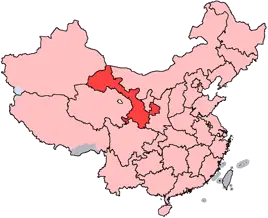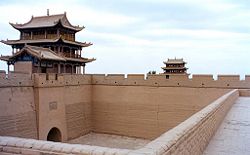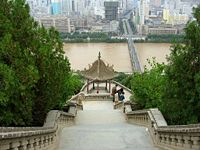Difference between revisions of "Gansu" - New World Encyclopedia
Dan Davies (talk | contribs) (imported, credited, claimed) |
Dan Davies (talk | contribs) (started tag) |
||
| Line 1: | Line 1: | ||
| − | {{claimed}} | + | {{started}}{{claimed}} |
{{coor title dm|38|0|N|102|20|E|region:CN_type:adm1st}} | {{coor title dm|38|0|N|102|20|E|region:CN_type:adm1st}} | ||
{{Infobox PRC province | {{Infobox PRC province | ||
Revision as of 23:37, 7 November 2007
| 甘肃省 Gānsù Shěng | |
| Abbreviations: 甘 or 陇 (Pinyin: Gān or Lǒng) | |

| |
| Origin of name | 甘 gān - Ganzhou (Zhangye) 肃 sù - Suzhou (Jiuquan) |
| Administration type | Province |
| Capital (and largest city) |
Lanzhou |
| CPC Ctte Secretary | Su Rong |
| Governor | Xu Shousheng (acting) |
| Area | 454,000 km² (7th) |
| Population (2004) - Density |
26,190,000 (22nd) 57.7/km² (27th) |
| GDP (2005) - per capita |
CNY 192.8 billion (27th) CNY 7,487 (29th) |
| HDI (2005) | 0.675 (medium) (28th) |
| Major nationalities | Han - 91% Hui - 5% Dongxiang - 2% Tibetan - 2% |
| Prefecture-level | 14 divisions |
| County-level | 86 divisions |
| Township-level† | 1344 divisions |
| ISO 3166-2 | CN-62 |
| Official website http://www.gansu.gov.cn (Simplified Chinese) | |
| Source for population and GDP data: 《中国统计年鉴—2005》 China Statistical Yearbook 2005 Source for nationalities data:ISBN 7503747382 《2000年人口普查中国民族人口资料》 Tabulation on nationalities of 2000 population census of China † As at December 31, 2004
ISBN 7105054255 | |
Gansu ▶ (Simplified Chinese: 甘肃; Traditional Chinese: 甘肅; pinyin: Gānsù; Wade-Giles: Kan-su, Kansu, or Kan-suh) is a province located in the northwest of the People's Republic of China. It lies between Qinghai, Inner Mongolia, and the Huangtu Plateaus, and borders Mongolia to the north and Xinjiang to the west. The Huang He river passes the southern part of the province. It has a population of approximately 25 million (1997) and has a large concentration of Hui Chinese. The capital of the province is Lanzhou, located in the southeast part of Gansu. Gansu is abbreviated Gan or Long (陇/隴), and is also known as Long West or Long Right, in reference to the Long Mountain east of Gansu.
Administration
There are fourteen administrative areas in Gansu immediately below the province level: twelve prefecture-level cities and two autonomous prefectures:
- Baiyin City (白银 Báiyín)
- Dingxi City (定西 Dìngxī)
- Gannan Tibetan Autonomous Prefecture (甘南 : Gānnán Zāngzú)
- Jiayuguan City (嘉峪关 : Jiāyùguān)
- Jinchang City (金昌 : Jīnchāng)
- Jiuquan City (酒泉 : Jiǔquán)
- Lanzhou City (兰州 : Lánzhōu)
- Linxia Hui Autonomous Prefecture (临夏 : Línxià Huízú)
- Longnan City (陇南 : Lǒngnán)
- Pingliang City (平凉 : Píngliàng)
- Qingyang City (庆阳 : Qìngyáng)
- Tianshui City (天水 : Tiānshuǐ)
- Wuwei City (武威 : Wǔwēi)
- Zhangye City (张掖 : Zhāngyè)
History
Gansu is an acronym first used in Song Dynasty, China, of two Sui and Tang Dynasty prefectures (州): Gan (around Zhangyi) and Su (around Jiuquan).
In prehistoric times, Gansu was host to a number of Neolithic cultures. The Dadiwan culture, from where numerous archaeologically significant artifacts have been excavated, flourished in the eastern end of Gansu from about 6000 B.C.E. to about 3000 B.C.E. [1]. The Majiayao culture (馬家窯文化) and part of the Qijia culture (齊家文化) also took root in Gansu from 3100 B.C.E. to 2700 B.C.E. and 2400 B.C.E. to 1900 B.C.E. respectively.
The Qin state (秦), later to become the founding state of the Chinese empire, grew out from the southeastern part of Gansu, specifically the Tianshui (天水) area. The Qin name itself is believed to have originated, in part, from the area [2][3]. Qin tombs and artifacts have been excavated from Fangmatan near Tianshui, including one 2200 year old map of Guixian county [4].
In imperial times, Gansu was an important strategic outpost and communications link for the Chinese empire, as the Hexi corridor (河西走廊) runs along the "neck" of the province. The Han dynasty extended the Great Wall across this corridor, also building the strategic Yumenguan (Jade Gate Pass, near Dunhuang) and Yangguan (阳关) fort towns along it. Remains of the wall and the towns can be found there to this date. The Ming dynasty also built the Jiayuguan outpost in Gansu. To the west of Yumenguan and the Qilian mountains, at the northwestern end of the province, the Yuezhi, Wusun, and other nomadic tribes dwelt (Shiji 123), occasionally figuring in regional imperial Chinese geopolitics.
| Deadliest earthquakes | ||||
|---|---|---|---|---|
| Rank | Earthquake | Country | Year | Fatalities |
| 1 | "Shaanxi" | China | 1556 | 830,000 |
| 2 | "Indian Ocean" | nr. Indonesia | 2004 | 283,100 |
| 3 | "Tangshan" | China | 1976 | 242,000 |
| 4 | "Aleppo" | Syria | 1138 | 230,000 |
| 5 | "Gansu" | China | 1920 | c. 200,000 |
Situated along the Silk Road, Gansu was an economically important province, and a cultural transmission path as well. Temples and Buddhist grottoes [5] such as those at Mogao Caves ('Caves of the Thousand Buddhas') and Maijishan Caves contain artistically and historically revealing murals.[6] An early form of paper inscribed with Chinese characters and dating to about 8 B.C.E. was discovered at the site of a Western Han garrison near the Yumen pass in August 2006 [7].
Many parts of the province saw heavy fighting during the Muslim Rebellion of 1862-77.
Its frequent earthquakes, droughts and famines have tended to slow its economic progress, until recently when based on its abundant mineral resources it has begun developing into a vital industrial center. An earthquake in Gansu at 8.6 on the Richter scale killed around 180,000 people in 1920, and another with a magnitude of 7.6 killed 70,000 in 1932.
Geography
Gansu province has an area of 454,000 km², and the majority of its land is more than 1 km above sea level. It lies between the Tibetan Plateau, Inner Mongolia, and the Loess Plateau, and borders Mongolia to the north-west. The Huang He river passes through the southern part of the province. The province contains the geographical center of China, marked by the Center of the County Monument at {{#invoke:Coordinates|coord}}{{#coordinates:35|50|40.9|N|103|27|7.5|E|region:CN_type:landmark | |name=Geographical centre of China }} [8].
Part of the Gobi Desert is located in Gansu.
The Yellow River (Huang He) gets most of its water from Gansu province. The Yellow River also flows straight through Lanzhou.
The landscape in Gansu is very mountainous in the south and flat in the north. The mountains in the south are part of the Qilian mountain range. At 5,547 meters high, Qilian Shan Mountain is Gansu’s highest elevation. It is located at latitude 39°N and longitude 99°E.
Neighboring provinces: Inner Mongolia, Xinjiang, Qinghai, Sichuan, Shaanxi, and Ningxia.
Other cities include:
- Yumen
- Xiahe
Economy
Agricultural production includes cotton, linseed oil, maize, melons (the Bailan melon is well known in China), millet, and wheat. Gansu is known as a source for wild medicinal herbs which are used in Chinese medicine.
However, most of Gansu's economy is based on mining and the extraction of minerals, especially rare earth elements. The province has significant deposits of antimony, chromium, coal, cobalt, copper, fluorite, gypsum, iridium, iron, lead, limestone, mercury, mirabilite, nickel, crude oil, platinum, troilite, tungsten, and zinc among others. The oil fields at Yumen and Changqing are considered significant.
Industries other than mining include electricity generation, petrochemicals, oil exploration machinery, and building materials.
According to some sources, the province is also a center of China's nuclear industry.
Gansu is considered to be one of the poorest provinces in China. Its nominal GDP for 2004 was about 155.9 billion yuan (19.34 billion USD) and per capita of 5010 RMB (605 USD).
Demographics
Gansu province is home to 26,033,400 people. Most of the population, 73%, is still rural. Gansu is 92% Han and also has Hui, Tibetan, Dongxiang, Tu, Manchu, Uyghur, Yugur, Bonan, Mongolian, Salar, and Kazakh minorities.
Language
Most of the inhabitants of Gansu speak dialects of Northern Mandarin Chinese. On the border areas of Gansu you may hear Amdo Tibetan, Mongolian, and Kazakh. Most of the minorities also speak Chinese, except for the Mongolian speaking Tu minority who are said to seldom speak a second language.
Culture
The cuisine of Gansu is based on the staple crops grown there: wheat, barley, millet, beans, and sweet potatoes. Within China, Gansu is known for its pulled noodles, and Muslim restaurants which feature authentic Gansu cuisine are common in most major Chinese cities.
Tourism
The Jiayuguan Pass of the Great Wall
Jiayuguan Pass, in Jiayuguan city, is the largest and most intact pass, or entrance, of the Great Wall. Jiayuguan Pass was built in the early Ming dynasty, somewhere around the year 1372. It was built near an oasis that was then on the extreme western edge of China. Jiayuguan Pass was the first pass on the west end of the great wall so it earned the name “The First And Greatest Pass Under Heaven.”
An extra brick is said to rest on a ledge over one of the gates. One legend holds that the official in charge asked the designer to calculate how many bricks would be used. The designer gave him the number and when the project was finished, only one brick was left. It was put on the top of the pass as a symbol of commemoration. Another account holds that the building project was assigned to a military manager and an architect. The architect presented the manager with a requisition for the total number of bricks that he would need. When the manager found out that the architect had not asked for any extra bricks, he demanded that the architect make some provision for unforeseen circumstances. The architect, taking this as an insult to his planning ability, added a single extra brick to the request. When the gate was finished, the single extra brick was, in fact, extra and was left on the ledge over the gate.
Mogao Grottoes
The Mogao Grottoes near Dunhuang represent an astonishing collection of Buddhist art and religion. Originally there were a thousand grottoes, but now only 492 cave temples remain. Each temple has a large statue of a buddha or bodhisattva and paintings of religious scenes. In 336 AD, a monk named Le Zun (Lo-tsun) came near Echoing Sand Mountain, when he had a vision of golden rays of light shining down on him like a thousand Buddhas. Le Zun started to carve the first grotto to memorize the incident. During the Five Dynasties period they ran out of room on the cliff and could not build anymore grottoes. Now they have started to find old paintings that were painted over in the Five Dynasties.
Silk Road and Dunhuang City
The historic Silk Road starts in Chang'an and goes to Constantinople. On the way merchants would go to Dunhuang in Gansu. In Dunhuang they would get fresh camels, food and guards for the journey around the dangerous Taklamakan Desert. Before departing Dunhuang they would pray to the Mogao Grottoes for a safe journey, if they came back alive they would thank the gods at the grottoes. Across the desert they would form a train of camels to protect themselves from thieving bandits. The next stop, Kashi (Kashgar), was a welcome sight to the merchants. At Kashi most would trade and go back and the ones who stayed would eat fruit and trade their Bactrian camels for single humped ones. After Kashi they would keep going until they reached their next destination.
Bingling Temple
Bingling Temple, or Bingling Grottoes, is a Buddhist cave complex in a canyon along the Yellow River. Begun in 420 AD during the Western Jin Dynasty, the site contains dozens of caves and caverns filled with outstanding examples of carvings, sculpture, and frescoes. The great Maitreya Buddha is more than 27 meters tall and is similar in style to the great Buddhas that once lined the cliffs of Bamiyan, Afghanistan. Access to the site is by boat from Yongjing in the summer or fall. There is no other access point.
Labrang Monastery
Labrang Tashikyil Monastery is located in Xiahe County, Gannan Tibetan Autonomous Prefecture, located in the southern part of Gansu, and part of the traditional Tibetan province of Amdo. It is one of the six major monasteries of the Gelukpa tradition of Tibetan Buddhism in Tibet, and the most important one in Amdo. Built in 1710, it is headed by the Jamyang-zhaypa. It has 6 dratsang (colleges), and houses over sixty thousand religious texts and other works of literature as well as other cultural artifacts.
Miscellaneous topics
The Jiuquan Satellite Launch Center is located in the Gobi desert in Gansu Province.
Postage stamps
In August 1949, the provincial government overprinted the nondenominated stamps "locomotive" and "airmail arrow" stamps issued by the central government. These overprints were made by handstamping in purple, and are quite rare, valued at over US$500 each. Counterfeits are known, and apparent examples should be expertized.
Education
Colleges and universities
- Lanzhou University (Lanzhou)
- Gansu Agricultural University
Natural resources
Land
- 166,400 km² grassland
- 46,700 km² mountain slopes suitable for livestock breeding
- 46,200 km² forests (standing timber reserves of 0.2 km³)
- 35,300 km² cultivated land (1,400 m² per capita)
- 66,600 km² wasteland suitable for forestation
- 10,000 km² wasteland suitable for farming
- 454,000 km² total area
Minerals
Three thousand deposits of 145 different minerals. Ninety-four minerals have been found and ascertained, including nickel, cobalt, platinum, selenium, casting clay, finishing serpentine, and five other minerals whose reserves are the largest in China.{{cn} Gansu has advantages in getting nickel, zinc, cobalt, platinum, iridium, copper, barite, and baudisserite.
Energy
Among Gansu’s most important sources of energy are its water resources: the Yellow River and other inland river drainage basins. Gansu is placed ninth among China’s provinces in annual hydropower potential and water discharge. Gansu produces 17.24 gigawatts of hydropower a year. Twenty-nine hydropower stations have been constructed in Gansu, each capable of generating 30 gigawatts. Gansu has an estimated coal reserve of 8.92 billion tons and petroleum reserve of 700 million tons. There is also good potential for wind and solar power development.
Flora and Fauna
Gansu has 659 species of wild animals. Among these are the giant panda, snub-nosed monkeys, antelopes, snow leopards, deer, fawn, musk deer, and the Bactrian camel. It also has twenty-four other rare animals which are under a state protection. Gansu is home to 441 species of birds; especially among these, it is a center of endemism and home to many species and subspecies which occur nowhere else in the world.
Gansu province is second place in China for most medicinal plants and herbs, including some odd ones like hairy asiabell root, fritillary bulb, and Chinese caterpillar fungus.
External links
- 甘肅省人民政府網站 (Gansu People's Government Website) (in Simplified Chinese)
- Large map of Gansu
- Gansu, the Mainland's "Little Lhasa" Newspaper travel report about Gansu Province
- The Pilgrims of Langmusi Article about Sichuanese-Tibetan Buddhist pilgrims in Langmusi
ReferencesISBN links support NWE through referral fees
| Province-level divisions administered by the People's Republic of China (PRC) | |
|---|---|
| Provinces | Anhui · Fujian · Gansu · Guangdong · Guizhou · Hainan · Hebei · Heilongjiang · Henan · Hubei · Hunan · Jiangsu · Jiangxi · Jilin · Liaoning · Qinghai · Shaanxi · Shandong · Shanxi · Sichuan · Taiwan · Yunnan · Zhejiang |
| Autonomous regions | Guangxi · Inner Mongolia · Ningxia · Tibet (Xizang) · Xinjiang |
| Municipalities | Beijing · Chongqing · Shanghai · Tianjin |
| Special administrative regions | Hong Kong · Macau |
Prefecture-level divisions of Gansu
| ||||
| List of Gansu County-level divisions |
Credits
New World Encyclopedia writers and editors rewrote and completed the Wikipedia article in accordance with New World Encyclopedia standards. This article abides by terms of the Creative Commons CC-by-sa 3.0 License (CC-by-sa), which may be used and disseminated with proper attribution. Credit is due under the terms of this license that can reference both the New World Encyclopedia contributors and the selfless volunteer contributors of the Wikimedia Foundation. To cite this article click here for a list of acceptable citing formats.The history of earlier contributions by wikipedians is accessible to researchers here:
The history of this article since it was imported to New World Encyclopedia:
Note: Some restrictions may apply to use of individual images which are separately licensed.


